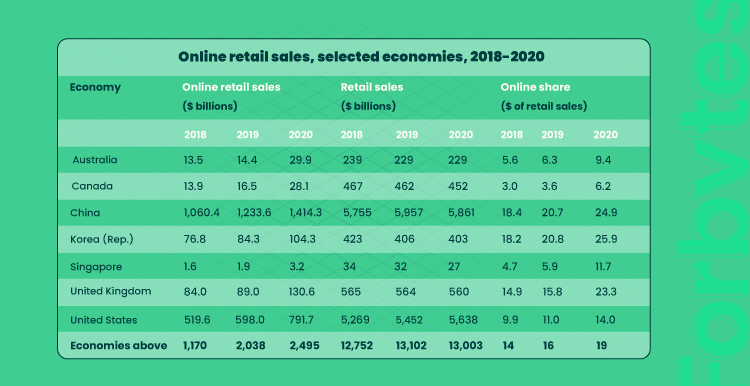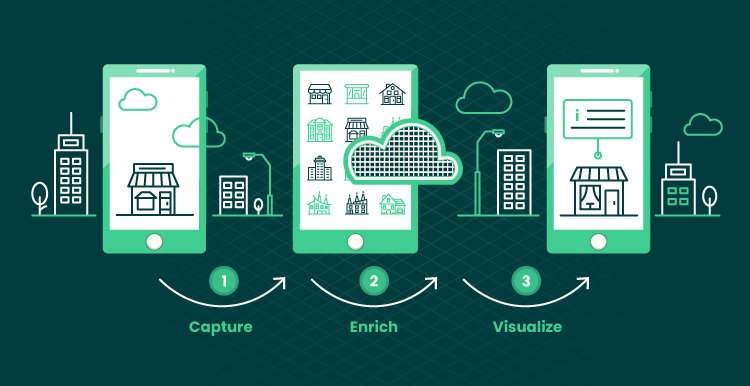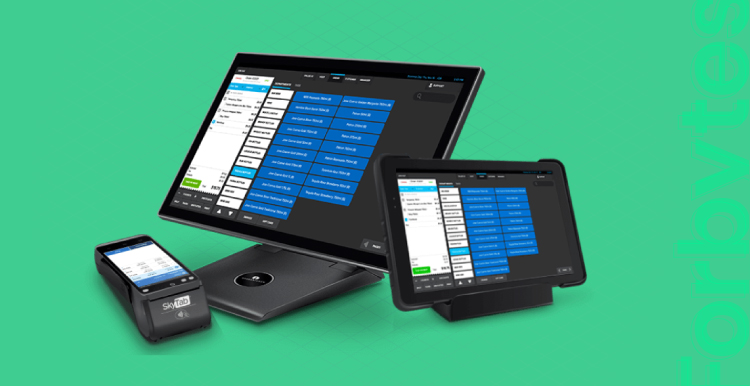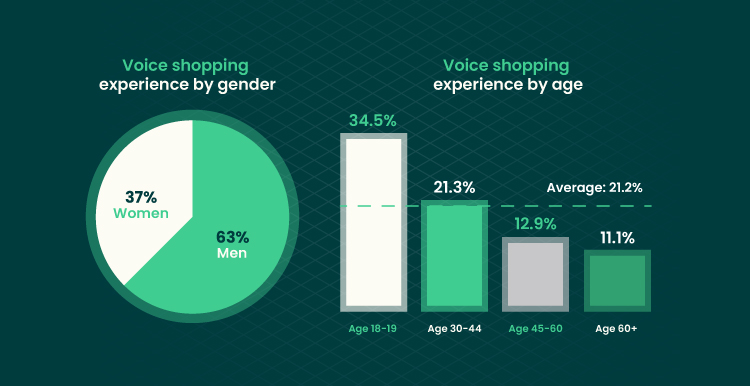Has your life changed after the pandemic became a part of our everyday vocabulary? 2 years ago, we faced one of the biggest challenges of the 21st century — COVID-19. We didn’t know how we would cope with all the problems and what would happen to the global economy and business. The latter faced the crisis but restarted at some point, and any retailers adjusted to the new reality. The economic sector started its recovery.
But what will the future of retail technology and the ecommerce sector look like? Will it gradually return to the pre-Covid state? Or do some even more significant changes wait for businesspeople in the nearest time?
In this article, we investigate the future of retail concerning the digital transformation it has faced.
What to Be Ready for?
In 2020, the e-commerce industry and service sector experienced a historical decline. According to the Handbook of Statistics for 2021, world trade decreased by 7% once the pandemic started. Global exports fell by $1.5 trillion, marking the greatest fall in sales since 2009.
The situation in the service sector was even worse. The yearly value of global services fell by 20% in contrast to 2019. If to compare the decline of 2020 with the decline of 2009, the pandemic brought more adverse consequences to the service sector than the world crisis. This is a brief description of what the situation looked like in 2020:
And then humanity learned to adjust. The world economy started its slow but stable recovery. By the end of 2020, the commerce industry reached its pre-crisis metrics and even exceeded them. Brick-and-mortar retail stores began to invest in strengthening their online presence. Many of them built ecommerce websites and mobile applications and integrated AI models and chatbots into their solutions.
The same goes for the services trade, which in 2021 improved its metrics by 23% compared to the year before. And this is how. Restaurants started to offer delivery. Coaches and trainers began to launch online courses. Most industry representatives found ways to move (completely or partially) to the digital and grow their online sales.
Going online opened new opportunities for businesses across the globe. They expanded their client base by reaching other countries. Businesses also set a close connection with users. They began to integrate insightful data management into their retail strategies for better results, and so on.
The growth of social commerce formed the ground for a facilitated retail experience and took metrics up. Online sales of the key world economies also started to grow:
Looking at this, we may assume that the future of retail won’t be the same as we thought it to be a couple of years ago. What can we wait for, and how to prepare for the challenges and changes of tomorrow? Let’s analyze it step-by-step.
Bringing the Gap Between Offline and Online
The pandemic forever and ever changed the retail future. Consumers of the retail sector won’t be ready to sacrifice the convenience of technology when they return to physical stores. Yes, it would be nice to return to pre-covid habits. But still, some of these habits turned out to be pointless in the background of technology potential. People realized that they wasted so much time on the tasks that can be done in a few clicks online.
This is why the future of the retail industry will combine the benefits of offline and online. It will motivate clients to find ways to use of technology when buying offline. A great example of how this tendency will work is the application of augmented reality in commerce. Yes, we all know about the benefits of AR-powered apps that allow users to try goods before making online orders. And what if to use this technology in local shops?
AR in Offline Experience
Augmented reality will soon be one of the growing retail trends and an integral part of the in-store experience. One of its most effective applications is called trying before buying. It allows users to try goods online on the company’s website or app and then come to offline retail locations to make a purchase. It reduces the time spent in fitting room queues and makes the customer journey more goal-oriented.
Here is how AR generally works:
One more way to apply this cutting-edge technology in physical retail is linked to in-store stock management. Store employees will hold their smartphone’s camera up to a particular shelf and detect issues with the help of AR. This process will help them improve the placement of goods and zoning and lead to revenue growth accordingly.
How to know if products on a shelf are arranged properly? The answer also lies in the use of this technology. Product suggestions generated from user behavior analysis can be used for this purpose.
The same principle is applied to the analysis of offline purchases. The technology can identify frequent product combinations in receipts and detect trends. Employees will get insights from sales data and purchase history. This, in turn, will ease their effort in organizing product shelves and finding the right item combination and order.
AI-Powered Store Management
There is nothing new in the fact that AI development is applied for better management. The future retail transformations are not going to ruin this trend. Instead, the retail of the near future is going to extend it. Most ecommerce businesses know how useful it is to integrate AI-powered data into their management strategy. The same can be done in stock management.
With AI technology integrated offline, store associates will optimize the number of goods presented on the sales floor. Should they change the number of identical items on the shelf to increase product visibility? What product combination attracts user attention the most? The answers to these questions can be generated from AI-driven data on offline store management.
Online Predictions on the Offline Demand
At the start of the pandemic, we all witnessed how people swept products off the shelves, leaving empty spaces hereafter. While some products were in high demand, others kept being almost untouched throughout the whole period of panic. To prevent shortages, a retail business will rely on AI-powered demand prediction, one more type of future retail technology.
Demand forecasting can be relevant for both offline retail and e-commerce. The greatest advantage of AI-driven analysis is its adaptiveness. That is, to get a personalized output, you only need to choose the right input data. This can be data from digital channels or offline store experiences.
Retailers will be able to facilitate inventory management, communication, logistics, and promotion with AI. In the background of changing consumer behavior, businesses need to be aware of such data. Forecasting demands will help them build a more efficient strategy and directly influence the customer journey. Moreover, predictions on demand can help reduce the inefficient consumption of goods. This is a part of the green philosophy — one of the greatest digital transformation trends in the retail sector.
What Will We See in Brick-and-Mortar Stores?
When we think about a point of sale, we imagine a cash register that allows retailers to accept payments from clients and manage stock. Usually, the POS system in a physical store looks like this:
What’s inside such a system? The time of primitive stock management is coming to an end. Now, we see how POS (point of sale) is becoming more complex and multi-function. Let’s look at this retail technology more in-depth.
Adjusted POS Systems
The evolution of POS systems is a powerful digitalization trend. Such systems enable retailers to manage their business in real-time. No need for manual updates. As soon as a customer or an employee makes an action in the system, it synchronizes data across channels.
With the rise of Covid-19, retailers were looking for any way to stay competitive. This is how many of them came to different forms of accepting orders. Some commerce businesses offered BOPIS (buy online and pick up in store). Others presented clients with the chance for same-day delivery. They tried to ensure that their offline stores remain relevant and maintained the balance between offline and online. This was one of the reasons why POS systems were adjusted to multichannel commerce. The latter allows for the management of stock in general and across channels.
Suppose that you have 100 items in storage. 10 items were reserved on your ecommerce website, and 23 were sold offline. You have 67 items left. But some clients decide to cancel the reserved orders and you get 5 items back to your general quantity. How to inform a store associate about the stock changes promptly? The answer is, to use a unified POS system that allows for real-time data updates and effective stock management.
Integrated Indoor Positioning
Bill Gates once said, “Your most unhappy customers are your greatest source of learning.” By investigating customer behavior, you increase the chances of converting them into a customer.
Indoor positioning is a technology that can help you reach this goal. First and foremost, indoor positioning systems (IPSs) are used for in-store navigation. Why not use GPS? A good question. GPS technology is accurate when it comes to a location as a whole. Yet, when we talk about a particular area inside the location, GPS lacks accuracy and cannot provide detailed guidance for a user.
In the Covid-19 reality, indoor positioning was examined as a means of social distancing control. The technology was expected to track customer’s locations and calculate the distance between people. Clients would get notifications if the distance wasn’t safe enough. Today, the role of IPS goes beyond distance calculations. Such systems can be implemented in a brick-and-mortar store system for better customer navigation and analytics.
If local customers who use your e-commerce application enter the store, they can get extra navigation tips. Indoor positioning technology can help them navigate through the sales floor in the search for a necessary item. The customer data gathered on the basis of client navigation can help you detect the places in your store that clients avoid. This, in turn, may point to a problem. There may be issues with item combination, bad access to goods on shelves, unattractive parts of the store interior, etc. This is how big data in retail may help you turn dissatisfied visitors into happy clients.
The use of indoor positioning systems is not limited to detecting weak spots in your store. You can use the data gathered from IPS for better product placement and effective use of high-traffic areas of your retail store. When you make some special offers or put products on sale, “hot” areas of your store will be the best for attracting client attention.
Is There Something New Entering the Game?
The Covid reality didn’t mark the start of some new digitalization trends. But it taught today’s retailers to use the old to build new business models. That is, they have learned how to follow ecommerce trends to make a difference in digital and build an exceptional customer experience. Let’s have a look at two important aspects of post-Covid retail that make the shopping process easier and more convenient.
Robotics Is Coming. But Not the Way You Expect
Some clients and retailers are afraid that in the future, robots will replace humans in business. Employees will lose their jobs, while customers will be deprived of the right to human contact and communication. Although the time of robotics is close, it won’t come the way people expect. Instead of taking away human jobs, robotics will facilitate interaction, drive ecommerce automation, and ease mundane tasks. And the results from such future investment can be revolutionary for your business.
Let’s take the delivery process as an example. Order delivery would be faster and easier if robotics took heavy orders to the destination instead of humans. Many companies (Uber, Tortoise, Grubhub) started to adopt autonomous delivery devices and vehicles even before the pandemic. But it also turned out to be a useful solution for a health safety problem. When Covid-19 came into people’s lives, the need for contactless delivery only arose. As for now, such tools are at the stage of testing and experiments. But as soon as they evolve, they can significantly reduce the delivery time and facilitate the order fulfillment process in general.
Doing Business by Word of Mouth
The rise of AI allowed for the improvement of NLP, or natural language processing. The technology teaches the machines to understand and process language and respond to client requests. A good example of NPL in action is the use of Alexa or Siri. These voice assistants are known for their actionable voice detection and recognition.
Voice commerce is gaining popularity. This digitalization trend demonstrates how to make queries effortlessly and get instant results. By using their voice, customers can do online shopping, make orders, provide order information details, look for goods and stores, choose the best product combination, and so on.
Still, there are data safety concerns associated with this trend. When making a request, the risks are that third-party people will hear it and use your information for the purpose of fraud. This is why voice commerce is not expected to replace traditional commerce and is treated as a complementary trend in future retail.
So What Is the Future of Retail?
Straight to the point. The future of retail will be penetrated by technology nearly in all aspects. This is not only about online retail. Brick-and-mortar locations are also under the influence of changes. But an important thing to highlight is that the digital world will not drive the extinction of offline retail. Instead, technology is smoothly entering the commerce industry. It creates a space for the growth of digitally native brands and independent retailers.
The future of retail will be based on effective human interaction, with little effort and maximum pleasure. If you also want to modernize your commerce business and prepare it for the challenges of tomorrow, leave us your contact details. If you are still wondering whether your choice of a partner is right, check the tips on how to choose an ecommerce development company.

Our Engineers
Can Help
Are you ready to discover all benefits of running a business in the digital era?

Our Engineers
Can Help
Are you ready to discover all benefits of running a business in the digital era?













